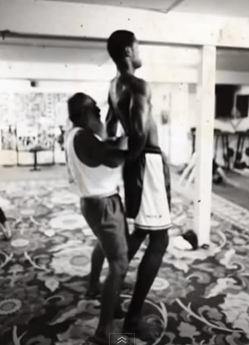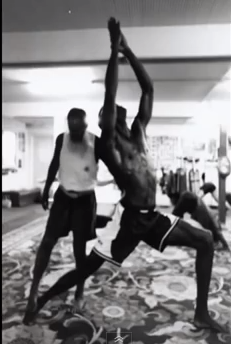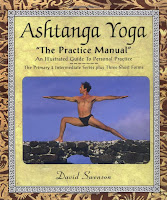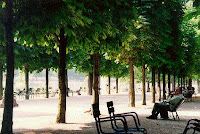"In 1973, Norman Allen was the first American to be taught by Pattabhi Jois. Norman attended a yoga demonstration at the Swami Gitananda Ashram in Pondicherry; the yoga was performed by Manju Jois, the son of Pattabhi Jois. Impressed by what he witnessed, he decided to study this system of yoga". from Ashtangayoga.info.
"... Pattabhi Jois he came with his wife and his daughter and his cousinand his nephew. (Guy - Vishvanath?) Yes, lean boy then, not lean now…But he was lean and really spiffy at one time so he came todemonstrate, Pattabhi Jois came to discuss, cousin came to translate, Ama came to take care of him. Saraswati was she there? I’m not sure.
A month or two before this conference, two young Indians from Mysoreshow up at the Ashram with Saris - wanting to sell saris and littlesarongs, and one of their names is Basaraju and one of them is Manju,OK? And they hung out there, in their young 20’s and this one boy Manjudemonstrates some Yoga postures that he had learned from his father… OhMan! look at that…
...and I wanna’ show you something... so I saw these boys do thisyoga work... so this one boy he had a card... and these were the two boys: far out huh? so that is Manju Jois, huh?
So, I saw Manju and Basaraju and then a month or two later saw his father and then saw
Vishvanath demonstrate and I said: “OK, this I want to learn”.
Guy: Had you ever seen anything like that before?
No, you know that time before we met, I saw the Iyengar book in thoseearly days and that was interesting and what we did was kind of nice, alittle bit of a mix with some Sivananda stuff, very nice......but notlike that...
I wanted to study (with Jois), there was no question, andI asked, and they said: “No, he does not want to take any foreignstudents at this time, and one of the reasons was that he had had thatbad experience”
Guy: So he didn’t want to have you as a student?
No, he didn’t… but I would bring them everything that they needed: water and coffeeand I’d go to town and there’s almonds and badami... and I had mybeautiful daughter with me and my wife... and my daughter had her one yearHindu initiation with a great scholar in the Ashram in Pondicheri....so she’s a little baby, you know, in the East they like babies…
Guy: So how did you persuade him?
Well, I didn’t keep on, but… I’m a nice guy (good vibes) and Amaji toldhim or asked him to give it a chance... so because of her....otherwisehe wouldn’t take us - there was no need. In those days he was teachingat the Sanskrit Patashala, 50 Rupees a month... and he would have hischetty merchants who were his patrons, you know, and they’d come and hehad a room where the locals would come (for yoga classes)...
So, he agreed to take me on as a student, and in a month or so Ishifted on to Mysore. At first, I stayed upstairs there, where theyreside still, undoubtedly, unless they got a new house"
For the full, fascinating, interview head over to Guy's place
http://aysnyc.org/index.php?option=com_content&task=view&id=48&Itemid=184
More excellent interviews on Guy's website
This little movie of out takes from Enlighten Me along with some grist old photos of Norman has been circling around for a couple of weeks I think, I caught up with it this week on fb.
https://www.youtube.com/watch?v=hUWVEgTsnlQ
A series of screenshots of photos from the movie, love this photo sequence,
![]()
UPDATE: This seems to be an outtakes version - from the notes
"Directed by Kate Churchill, outtakes from filming "Enlighten Up" a documentary film about yoga. The Norman Picture was put together as a gift to Norman Allen. Om Namah Shivaya & Aloha ! Enjoy :)"
The photos above are from 7.36-8.54
And this which is unfortunately Anonymous
http://yogahawaii.blogspot.jp/2007/05/cult-of-norman-allen.html?m=1
I wasn't sure whether to include it in this post because it is Anonymous and a on post blog but, I don't know, perhaps it's the British love of eccentrics but I came away from this post wanting to go to Hawaii practice with him even more.
UPDATE: My brother posted an old photo of me from 1983, the hair reminded me of norman Allen and this post.
 |
| Norman Allen: (1970's?) Screenshot of a photo from the You tube movie below |
This is a repost of one of my favourite posts, some glorious early photos of Norman Allen as well as a short documentary at the end of the post. Norman, as far as I know, still practicing, still teaching. Given that Pattabhi Jois is said to have stopped practicing Ashtanga Vinyasa relatively early, by my reckoning, Norman may now have been practicing longer than his teacher.
So why is it that Norman Allen isn't on 'the list'..... and never has been?
A short reminder of how the KPJAY list came about.
Originally Pattabhi Jois just gave his blessing to teach,
Tim Miller writes about this 'blessing to teach' following Pattabhi Jois' third trip to the US in 1980
"Guruji gathered us together for one final meeting. At this gathering he told us which westerners he felt were qualified to teach. It was a fairly short list—David, Brad, Nancy, Gary, and a few others. Since Brad had decided to move to Maui, he wanted me to take over his school in Encinitas. He asked Guruji, “What about Tim?” Guruji looked perplexed and said, “Who?” “Tim,” Brad repeated, and pointed at me. “Oh, that man,” Guruji replied, and studied me for a moment. “Yes, that man is some better, okay.” Dust. Tim Miller (http://timmiller.typepad.com/dust_by_tim_miller/)
Note: None of those names above, including Tim Miller, are on I believe Sharath's current list
I believe Tim Miller may have been the first to ask for an actual piece of paper.
In the 90s following the writing down and publishing of the count I heard a couple of teachers started suggesting there should be more formality around who should and who shouldn't teach.
I'm not sure when the Ashtanga.Com list first came about, 2004 I believe See my Ashtanga History 1980 to present for 2004 Ashtanga.com list (87 teacher) The Ashtanga.com list was originally just a resource of where teachers could be found, addresses/contact details (pre internet), the teachers were either recommended by Pattabhi Jois himself or by letters from senior/ long term teachers/practitioners etc.
Begs the question whether given the internet we even NEED a list any longer.
In 2008 there seems to have been a bit of a falling out between Ashtanga.com and AYRI ( later KPJAYI and now Sharathjois.com). AYRI own list came into being in 2008 I believe - See my Ashtanga History 1980 to present for the first list. Pattabhi jois wasn't well ( he died the following year ) and Sharath was taking more control of the shala. Letters were sent out asking teachers to return their letters of blessing to teach, certificates etc. to be renewed (although it appears some never were). They were told that they couldn't be on any other list ( i.e. the Ashtanga.com list).
So, by the time the the first KPJAYI list of authorised teachers came about, there was perhaps less warmth between Sharath and those first practitioners who actually did the ground work of spreading/propagating the practice. As far as I know, Norman Allen was never on the KPJAYI list, nor were David Williams, Nancy Gilgoff, David Swenson, or those teachers Tim Miller mentions above, Brad Ramsey, Anthony Gary Lopedota, they were never carried over from the Ashtanga.com list to the KPJAYI list.
One of Sharath's main arguments in his new code of conduct is that these teachers no longer came to Mysore. Although one might ask why, when they had practiced with Pattabhi Jois for decades, they SHOULD then come and bend the knee to Sharath, we might wonder if it indeed matters. Sharath is fond of insisting that the practice hasn't changed, if that is the case then there is surely need to come. He does mention that he has been running some teaching workshops for authorised teachers (Special trainings) and that these of course haven't been attended by the senior, early teachers. I've heard from a couple of Authorised teachers about the content of these expensive trainings run by Sharath and there really doesn't appear to be anything that stands out as essential to the new order, mostly just practice and conferences.
Given that these senior teachers, the elders of the practice, have practiced from their youth into middle age and beyond it strikes me that it is their experience that should be sort.
In the next few days I'll see about putting up some other post of those who are not on the list....and never have been.
Here's Norman.
It seems to be Norman Allen week on fb this week,
 |
| Norman Allen: (1970's?) Screenshot of a photo from the You tube movie below |
Some background to the interview and videos from Ashtanga.info
How Ashtanga Yoga found its way to the West
It was just a small photo in one of many yoga books. And yet this picture set a revolution in motion. It brought Europeans and Americans to Pattabhi Jois in India, and Ashtanga Yoga to the West.
In 1964, André van Lysebeth, a Belgian, found his way into Pattabhi Jois’s tiny Yogashala in Mysore. With his profound knowledge of Yoga and Sanskrit, André became intrigued by this old yogic system. He spent two months with Pattabhi Jois who taught him the first and second series. Among the many books André van Lysebeth wrote in the ensuing years, one carried the title "pranayama". André wrote this book directly after he spent time with Jois. A photograph of the guru including his name and address was published in "pranayama”. Through this book, Pattabhi Jois’s name started to spread slowly in the Western world, mainly in Europe. So it came as no surprise that quite a few Europeans were among the first Westerners who travelled to India with the goal of meeting Pattabhi Jois.
In 1973, Norman Allen was the first American to be taught by Pattabhi Jois. Norman attended a yoga demonstration at the Swami Gitananda Ashram in Pondicherry; the yoga was performed by Manju Jois, the son of Pattabhi Jois. Impressed by what he witnessed, he decided to study this system of yoga.
A little later, David Williams and Nancy Gilgoff joined the tiny Yogashala in Mysore. They were the first to invite Pattabhi Jois to California, USA, to teach a workshop, in 1975. Only ten to fifteen students participated in the first workshop. This was a very modest start, compared to the amount of people who attend Pattabhi’s classes today.
Manju Jois accompanied his father on this legendary trip. He decided to stay in America to spread the traditional technique of Ashtanga Yoga there.
As time went by, Ashtanga Yoga became more and more known in the Western world. Pattabhi Jois was invited to teach many workshops not only in the U.S. but also in Brazil, the UK and many other countries. Today, the Ashtanga Vinyasa Yoga is one of the most famous yoga traditions in the world. One can find Ashtanga yoga classes held almost everywhere. Stars such as Madonna and Sting commit themselves to this ancient practice, a fact which has undoubtedly increased the popularity of Ashtanga yoga even more.
*
A nice long Interview that you can sink your teeth into with Norman Allen with from Guy Donahaye's website Yoga Shala NYC
Below a taste of the interview, follow the link for the full Interview
"... Pattabhi Jois he came with his wife and his daughter and his cousinand his nephew. (Guy - Vishvanath?) Yes, lean boy then, not lean now…But he was lean and really spiffy at one time so he came todemonstrate, Pattabhi Jois came to discuss, cousin came to translate, Ama came to take care of him. Saraswati was she there? I’m not sure.
 |
| M.S. Viswanath, fondly known as Masterji by his students Masterjiyoga website |
A month or two before this conference, two young Indians from Mysoreshow up at the Ashram with Saris - wanting to sell saris and littlesarongs, and one of their names is Basaraju and one of them is Manju,OK? And they hung out there, in their young 20’s and this one boy Manjudemonstrates some Yoga postures that he had learned from his father… OhMan! look at that…
...and I wanna’ show you something... so I saw these boys do thisyoga work... so this one boy he had a card... and these were the two boys: far out huh? so that is Manju Jois, huh?
So, I saw Manju and Basaraju and then a month or two later saw his father and then saw
Vishvanath demonstrate and I said: “OK, this I want to learn”.
Guy: Had you ever seen anything like that before?
No, you know that time before we met, I saw the Iyengar book in thoseearly days and that was interesting and what we did was kind of nice, alittle bit of a mix with some Sivananda stuff, very nice......but notlike that...
I wanted to study (with Jois), there was no question, andI asked, and they said: “No, he does not want to take any foreignstudents at this time, and one of the reasons was that he had had thatbad experience”
Guy: So he didn’t want to have you as a student?
No, he didn’t… but I would bring them everything that they needed: water and coffeeand I’d go to town and there’s almonds and badami... and I had mybeautiful daughter with me and my wife... and my daughter had her one yearHindu initiation with a great scholar in the Ashram in Pondicheri....so she’s a little baby, you know, in the East they like babies…
Guy: So how did you persuade him?
Well, I didn’t keep on, but… I’m a nice guy (good vibes) and Amaji toldhim or asked him to give it a chance... so because of her....otherwisehe wouldn’t take us - there was no need. In those days he was teachingat the Sanskrit Patashala, 50 Rupees a month... and he would have hischetty merchants who were his patrons, you know, and they’d come and hehad a room where the locals would come (for yoga classes)...
So, he agreed to take me on as a student, and in a month or so Ishifted on to Mysore. At first, I stayed upstairs there, where theyreside still, undoubtedly, unless they got a new house"
For the full, fascinating, interview head over to Guy's place
http://aysnyc.org/index.php?option=com_content&task=view&id=48&Itemid=184
More excellent interviews on Guy's website
*******
https://www.youtube.com/watch?v=hUWVEgTsnlQ

And one more movie from You Tube...
A Day With Norman Allen
Norman visits with long-time friend from India. Shot using a Nikon D600.UPDATE: This seems to be an outtakes version - from the notes
"Directed by Kate Churchill, outtakes from filming "Enlighten Up" a documentary film about yoga. The Norman Picture was put together as a gift to Norman Allen. Om Namah Shivaya & Aloha ! Enjoy :)"
The photos above are from 7.36-8.54
And this which is unfortunately Anonymous
The Cult of Norman Allen
http://yogahawaii.blogspot.jp/2007/05/cult-of-norman-allen.html?m=1
I wasn't sure whether to include it in this post because it is Anonymous and a on post blog but, I don't know, perhaps it's the British love of eccentrics but I came away from this post wanting to go to Hawaii practice with him even more.
UPDATE: My brother posted an old photo of me from 1983, the hair reminded me of norman Allen and this post.























































































